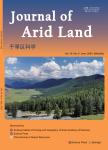Streamflow responses to climate change and LUCC in a semi-arid watershed of Chinese Loess Plateau
Streamflow responses to climate change and LUCC in a semi-arid watershed of Chinese Loess Plateau作者机构:School of Water Conservancy North China University of Water Resources and Electric Power School of Water Conservancy and Environment Zhengzhou University
出 版 物:《Journal of Arid Land》 (干旱区科学(英文版))
年 卷 期:2017年第9卷第4期
页 面:609-621页
核心收录:
学科分类:0710[理学-生物学] 0830[工学-环境科学与工程(可授工学、理学、农学学位)] 0709[理学-地质学] 08[工学] 0708[理学-地球物理学] 081501[工学-水文学及水资源] 0815[工学-水利工程] 0705[理学-地理学]
基 金:funded by the National Natural Science Foundation of China (41501025, 51609083, 41401038, 51509089) the 2016 Key Scientific Research Projects for Universities of Henan Province (16A170014)
主 题:streamflow LUCC climate change Mann Kendall test elasticity method Loess Plateau
摘 要:Climate change and Land Use/Cover Change(LUCC) have been identified as two primary factors affecting watershed hydrological regime. This study analyzed the trends of streamflow, precipitation, air temperature and potential evapotranspiration(PET) from 1962 to 2008 in the Jihe watershed in northwestern Loess Plateau of China using the Mann-Kendall test. The streamflow responses to climate change and LUCC were quantified independently by the elasticity method. The results show that the streamflow presented a dramatic decline with a turning point occurred in 1971, while the precipitation and PET did not change significantly. The results also show that the temperature rose markedly especially since 1990 s with an approximate increase of 1.74°C over the entire research period(1962–2008). Using land use transition matrix, we found that slope cropland was significantly converted to terrace between 1970 s and 1990 s and that forest cover increased relatively significantly because of the Grain for Green Project after 2000. The streamflow reduction was predominantly caused by LUCC and its contribution reached up to 90.2%, while the contribution of climate change to streamflow decline was only 9.8%. Although the analytical results between the elasticity method and linear regression model were not satisfactorily consistent, they both indicated that LUCC(human activity) was the major factor causing streamflow decline in the Jihe watershed from 1962 to 2008.



